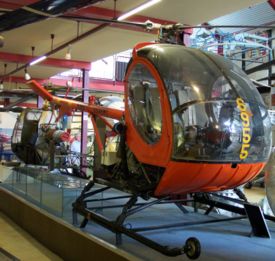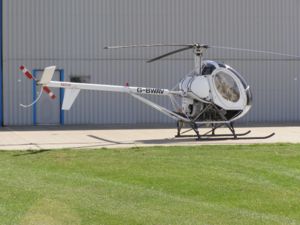PlaneSpottingWorld welcomes all new members! Please gives your ideas at the Terminal.
TH-55 Osage
| TH-55 Osage Hughes 269 | |
|---|---|
| Hughes TH-55 Osage | |
| Type | Light utility and trainer helicopter |
| Manufacturer | Hughes Helicopters |
| Maiden flight | October 1956 |
| Primary user | United States Army |
| Produced | 1961-1983[1] |
| Number built | 2800[2] |
| Variants | Schweizer 300 |
The Hughes TH-55 Osage was a piston-powered light training helicopter produced for the United States Army. It was also produced as the Model 269 family of light utility helicopters, some of which were maketed as the Model 300. The Model 300C was produced and further developed by Schweizer after 1983.
Contents
Development
In 1955, Hughes Tool Company's Aircraft Division carried out a market survey which showed that there was a demand for a low-cost, lightweight two-seat helicopter.[1] The division began building the Model 269 in September 1955. It was initially designed as a fully-glazed cockpit with seating for two pilots, or a pilot and passenger, It also had an open-framework fuselage and a three-blade articulated rotor. The prototype flew on 2 October 1956,[3] but it wasn't until 1960 that the decision was made to develop the helicopter for production.[1] The original truss-work tailboom was replaced with a tubular tailboom and the cockpit was restructured and refined prior to being put into production, and Hughes successfully captured a large portion of the civilian helicopter market[3] with an aircraft that would prove itself popular in agriculture, police work and other duties.
Design
The Hughes 269 was created with a fully articulated, counter-clockwise rotating, three-bladed main rotor, and a two-bladed tail rotor that would remain as distinctive characteristics of all its variants. It also has shock absorber-dampened, skid-type landing gear. The flight controls are directly linked to the control surfaces of the helicopter so there are no hydraulics in the 269. There are generally two sets of controls, although this was optional on the civil 269A. For three-seat aircraft, the middle collective control stick is removable and a seat cushion can be put in its place for the third passenger.
Operational history
In 1958, prior to full-time production, Hughes provided five pre-production Model 269 examples to the U.S. Army for evaluation as a light observation helicopter to replace the aging OH-13 Sioux and OH-23 Raven. Designated as the YHO-2HU[1][4][5] the helicopter was eventually turned down. 9 April 1959, the 269 received certification from the FAA and Hughes continued to concentrate on civil production. With some design changes, deliveries of the Model 269A version began in 1961. By mid-1963 about 20 aircraft were being produced a month and by the spring of 1964, 314 had been built.[1]
While the Army hadn't found the Model 269 adequate for combat missions, in 1964 it adopted the Model 269A as its training helicopter to replace the TH-23 and designated it the TH-55A Osage.[5] 792 TH-55 helicopters would be delivered by 1969, and it would remain in service as the Army's primary helicopter trainer until it was replaced in 1988 by the UH-1 Huey. At the time of its replacement, over 60,000 Army pilots had trained on TH-55 making it the Army's longest serving training helicopter.[4] In addition to the US Army, Hughes delivered TH-55/269/300s to other military customers.[4]
In 1964, Hughes introduced the slightly-larger three-seat Model 269B which it marketed as the Hughes 300. That same year, the Hughes 269 set an endurance record of 101 hours. To set the record, two pilots took turns piloting the aircraft and hovered in ground-effect for fueling. To ensure no cheating, eggs were affixed to the bottom of the skid gear to register any record-ending landing.[3]
The Hughes 300 was followed in 1969 by the improved Hughes 300C (sometimes 269C), which first flew on 6 March 1969 received FAA certification in May 1970.[1] This new model introduced a more powerful 190hp (140kW) Lycoming HIO-360-D1A engine and increased diameter rotor, giving a payload increase of 45%, plus overall performance improvements.[4] It was this model that Schweizer began building under license from Hughes in 1983.[6] In 1986, Schweizer acquired all rights to the helicopter from McDonnell Douglas, who had purchased Hughes Helicopters in 1984 and renamed it McDonnell Douglas Helicopter Systems. For a few years after Schweizer acquired the FAA Type Certificate it was known as the Schweizer-Hughes 300. And, while Schweizer made over 250 minor improvements, the basic design remained unchanged.
Between Hughes and Schweizer, and including foreign-licensed production civil and military training aircraft, nearly 3,000 copies of the Model 269/300 have been built and flown over the last 50 years. And that would be the end of the story, however, Schweizer continued to develop the model 300 by adding a turbine and redesigning the body to create the model 330. And then further developing the dynamic components to take greater advantage of the power of the turbine engine led to the development of the Model 333.
Variants
- Hughes 269
- Two prototype aircraft powered by a 180 hp Lycoming O-360-A engine and had a truss tail boom. First flown on 2 October 1956.
- 269A
- Replacing the prototype truss tail boom with a tapered monocoque, aluminum tail boom, the 269A came with the option of 180 hp Lycoming engines; the low-compression O-369-C2D, the high compression HO-360-B1B, or the fuel-injected HIO-360-B1A. Customers also had the option for dual controls, and a 19 gal (72 liter) auxiliary tank.
- YHO-2
- Five 269A aircraft evaluated by the U.S. Army for an observation helicopter in 1957-58. The Army did not order the YHO-2 due to lack of funds.
- TH-55A
- 792 model 269A helicopters purchased by the U.S. Army between 1964 and 1967. Selected as its standard training helicopter and named after the Osage native American tribe. It was fitted with military radio and instrumentation. An experimental TH-55A was fitted with an Allison 250-C18 turboshaft engine, and another would be fitted with a 185 hp Wankel RC 2-60 rotary engine.
- TH-55J
- 38 license-produced versions of the 269A, built by Kawasaki Jukogyo KK for the Japanese Ground Self-Defence Force
- 269A-1 "Model 200"
- The 269A-1 was a deluxe model of the 269A featuring custom interior, paint, cyclic trim and was marketed as the Hughes Model 200.[7] The Model 200 also offered an optional 30 gal (114 liter) main fuel tank instead of the standard 25 gal (95 liter) tank, however, it did not come with the O-369-C2D engine option.
- 269B "Model 300"
- Featuring a three-seat cockpit, the 269B was powered by a 190 hp Lycoming HIO-360-A1A engine and was marketed as the Hughes Model 300. Optional floats were also available on the 300, the first time available on any 269-variant.
- 280U
- single-seat, utility version of the 269B with an electric clutch and trim system. The 280U could be fitted with spraying equipment for agricultural applications.
- 300AG
- 269B designed specifically for agricultural spraying with a 30 gal (114 liter) chemical tank on each side of the fuselage, and a 35 feet (10.67 m) spray boom.
- 300B
- 269B with a Quiet Tail Rotor installed to reduce exterior noise levels to that of a light airplane. The QTR was installed on all production models starting in June 1967 and offered as a kit for previously built aircraft.
- 269C "Model 300C"
- The 300C was powered by a 190 hp (141 kW) Lycoming HIO-360-D1A and had a larger diameter main rotor (26 ft 10 in compared to 25 ft 4 in). The larger rotor and engine giving it a 45% performance increase over previous 269-models. Hughes and Schweizer both marketed the 269C as the Model 300C.
- NH-300C
- License-built 269C by Italian aircraft manufacturing firm BredaNardi.
Operators
- YHO-2
- Template:USA: United States Army - 5
- Army Aviation Test Center (1957-58)
- Hughes 269A
- Template:ALG: Algerian Air Force
- Template:BRA: Brazilian Navy
- 1° Esquadrao de Helicopteros de Instrucao
- Template:SWE: Swedish Army - 2 as Hkp 5A (1962-1969)
- Hughes 269A-1
- Template:BRA: Brazilian Navy
- 1° Esquadrao de Helicopteros de Instrucao
- Template:ESP: Spanish Air Force as HE.20
- Escuadron 782
- Hughes 269B
- Template:PHI: Philippine Constabulary - 2
- PC/INP Air Unit
- TH-55A
- Template:COL: Colombian Air Force
- Escuela de Helicopteros
- Template:NGA: [citation needed]
- Template:THA: Royal Thai Army
- Template:USA: United States Army - 792
- Fort Wolters, Texas (1964-1973)
- Fort Rucker, Alabama (1973-1987)
- TH-55J
- Template:JPN: Japanese Ground Self-Defense Force - 38
- Hughes 269C
- Template:CRI: Ministry of Public Security
- Template:HAI: Haiti Air Force (disbanded) - 3
- Escadre d'Helicoptéres (1978-1988)[1]
- Template:IND: Indian Navy - 4 as Hu300
- INAS 562 (1971-circa 1985)[2]
- Template:PRK[1]
- Template:SLE: Republic of Sierra Leone Military Forces - 2 as Saab 300C (circa 1990)
- NH-300C
- Template:GRE: Hellenic Army Aviation - 17 (current)
Specifications
Hughes 269A
Data from Evergreen Aviation and Space Museum[3]
General characteristics
- Crew: 2
- Length: 28 ft 11 in (8.8 m)
- Rotor diameter: 25 ft (7.6 m)
- Height: 7 ft 11 in (2.4 m)
- Disc area: 196.8 ft² (18.1 m²)
- Empty weight: 896 lb (406 kg)
- Loaded weight: 1550 lb (703 kg)
- Powerplant: 1× Lycoming HIO-360-B1A , 180 hp (134 kW)
Performance
- Maximum speed: 78 kts (90 mph)
- Cruise speed: 65 kts (75 mph)
- Range: 203 nm (233 miles)
References
- ↑ 1.0 1.1 1.2 1.3 1.4 1.5 1.6 Hughes Model 269/300 accessed 1 October 2007
- ↑ FLUG REVIEW online accessed 1 October 2007
- ↑ 3.0 3.1 3.2 3.3 Evergreen Aviation and Space Museum accessed 1 October 2007
- ↑ 4.0 4.1 4.2 4.3 Frawley, 2002 p. 148.
- ↑ 5.0 5.1 Gunston, 1978. p. 205.
- ↑ Frawley, 2003. p. 190.
- ↑ Hirschberg and Daley, 7 July 2000
- Gunston, Bill The Illustrated Encyclopedia of the World's Modern Military Aircraft, Crescent Books, New York, NY USA, ca. 1978. ISBN 0-517-22477-1.
- Michael J. Hirschberg and David K. Daley US and Russian Helicopter Development In the 20th Century, 7 July 2000. accessed 1 October 2007
- Frawley, Gerard The International Directiory of Civil Aircraft, 2003-2004, Aerospace Publications Pty Ltd, 2003. ISBN 1-875671-58-7.
- Frawley, Gerard The International Directiory of Military Aircraft, Aerospace Publications Pty Ltd, 2002. ISBN 1-875671-55-2.
External links
See also
Related development
Comparable aircraft
Designation sequence
See also
Template:US Army helicopters
Template:USAF helicopters
Lists relating to aviation | |
|---|---|
| General | Timeline of aviation · Aircraft · Aircraft manufacturers · Aircraft engines · Aircraft engine manufacturers · Airports · Airlines |
| Military | Air forces · Aircraft weapons · Missiles · Unmanned aerial vehicles (UAVs) · Experimental aircraft |
| Notable incidents and accidents | Military aviation · Airliners · General aviation · Famous aviation-related deaths |
| Records | Flight airspeed record · Flight distance record · Flight altitude record · Flight endurance record · Most produced aircraft |



